Stinging nettle is a common plant that demands respect and offers many benefits and uses. Utilized throughout the ages, stinging nettle boasts benefits and uses that far out-weigh its unforgettable “sting”.
This post may contain affiliate links at no additional cost to you. By making your purchases through the links on this website, IMSL may make a small percentage at no direct cost to you. IMSL only promotes products we use & truly believe in. Please refer to my Privacy & Disclosures for further information. IMSL thanks you for your support!
It’s a love-hate relationship with stinging nettle. Love it for the plethora of benefits, both medicinally as well as nutritionaly & its many benefits and uses, and hate it for the memorable “sting” you can acquire while harvesting it.
Before we can get to the benefits and the uses of stinging nettle, let’s get to know the plant itself.
STINGING NETTLE PLANT
Stinging nettle, Urtica dioica, is a herbaceous plant native originally to Europe as well as Asia & N Africa, and can now be readily found growing throughout the world.
All nettles are part of the Nettle Family of plants, Urticaceae.
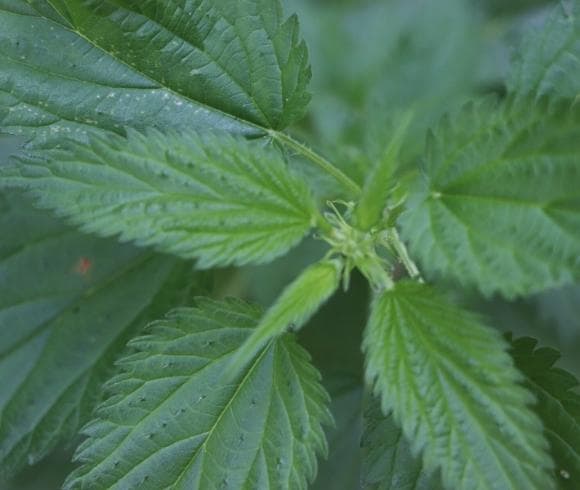
The scientific name, Urtica dioica, actually comes from the Latin “uro” which translates “to burn”.
Also referred to as common nettle, burn nettle (very apt in my humble opinion), nettle leaf, tall nettle, slender nettle, or just plain nettle, this plant grows readily in areas that are moist or receive a lot of rainfall.
That being said, I have large stands of stinging nettle growing near my compost pile as it enjoys the dappled sun & fertile nutrition it receives.
Nettle will and can attract a multitude of wildlife as a food source & safe habitat.
The nettle plant will grow and reproduce from both seed and rhizomes, although more often than not by rhizomes. When you find a single plant, you can be sure it was born from seed either blowing in the wind or via wildlife.
Stinging nettle is considered a perennial, coming back year-to-year.
The plant’s roots, stems, and leaves are all edible, beneficial, medicinal, and nutritional, with many uses.
HOW TO IDENTIFY STINGING NETTLE
Stinging nettle is fairly easy to identify and makes a great first for many beginner forager’s. There are a few tell-tale signs that you have the correct plant when looking to identify.
STINGING NETTLE STEMS
The nettle plant grows on a single, upright stalk, typically in dense stands, although single growing plant stems are not uncommon.
The stems are quite slim, slightly square in shape, and can grow to heights upwards of 8+ feet tall! Typically growing in a single stem fashion, meaning one stalk, you can occasionally discover thin branching along the main stem.
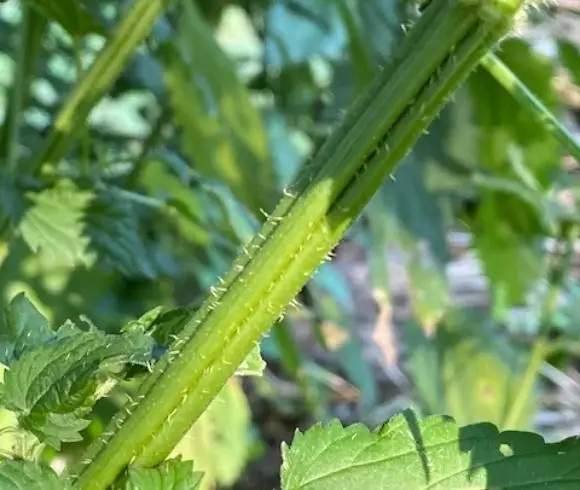
The stems are covered with many fine, tiny “hairs”, more on that below, which when touched can lead to an immediate stinging or burning sensation.
The stems can be deeply green in color or take on a purple hue. Both are normal.
The stems of young, tender nettle, typically prior to going to flower or seed, are edible. As the nettle matures, the stem becomes tough and fibrous, making them an unlikely candidate for eating.
However, the mature, fibrous stems can be utilized and made into twine, fishing nets, snares, cordage, and other fiber and textile uses.
STINGING NETTLE LEAF
The leaves of stinging nettle are dark green in color and grow in alternating opposition from each other.
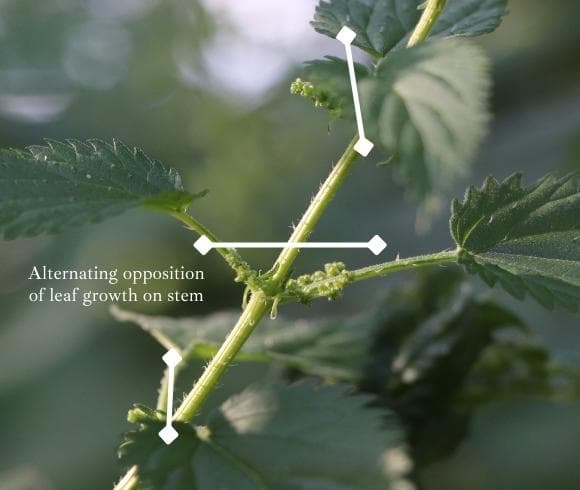
The serrated, deeply toothed edges of the leaf end in a point (acuminate) at the tip.
The leaf shape itself can either be considered triangular, especially for older mature leaves, or heart shaped (cordate), where the leaf meets its stem.
The leaf itself will be covered in tiny hairs which sting, although the majority of these hairs are found on the stems.
Younger stinging nettle leaves may appear to have a slight purple color or various shades of green.
Leaf size can vary anywhere from 3 cm to 15 cm (1 – 6 inches) depending on the stage of the plant’s growth.
STINGING NETTLE FLOWERS
The flower formations, which grow from the stem where the leaf grows (the leaf axil), are small and white to white/green (female flowers) in color. The male flowers can appear to be a green/yellow color and sometimes even purple..
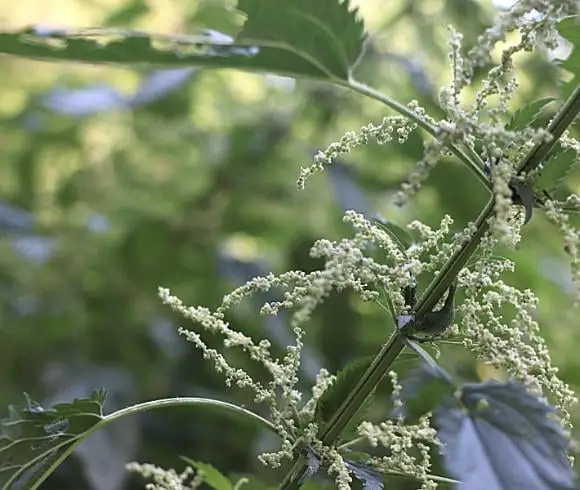
In fact, they are so tiny that they really don’t look like flowers at all.
STINGING NETTLE ROOTS
The nettle plant can be a bit invasive. So be forewarned should you want to plant and grow your own! Plant either in containers to control the spread or in an area where you don’t really care where it may pop up!
The root system of the plant is a vigorous one for sure! Spreading by stolons, a horizontal root which typically grows above ground, which then in turn produces an intricate formation of lateral rhizomes. These rhizomes will begin to creep and grow as well.
The rhizomes consist of 2 layers of growth; upper and lower. The upper layer is usually the younger root runners and the lower or deeper layer the more established. The lower level of root growth is fibrous, larger, and thicker in nature.
The roots of the nettle plant are easy to harvest, store, and use. They also offer their own unique uses, being both edible and medicinal.
STINGING NETTLES HAIRS
Why are stinging nettles so painful when touched? Both the leaves and the stems are covered in tiny hair-like protrusions (trichomes or spicules).
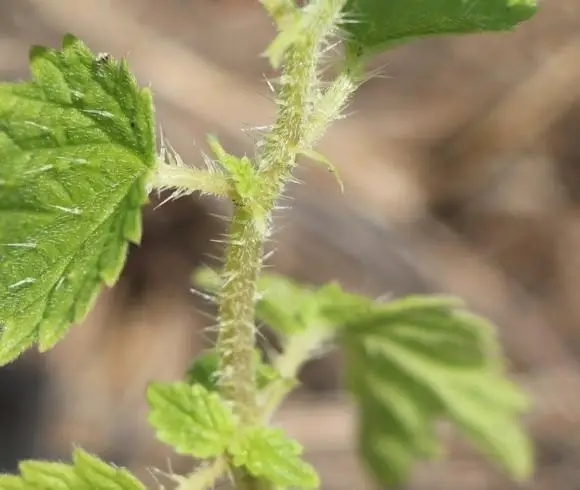
When touched, these stingers or hairs are transformed into a needle that immediately releases a natural skin irritant formula (including formic acid and histamine).
This natural chemical formula causes the “sting” or painful reaction(s).
DISCLAIMER
Recommendations and or suggestions made by this blog regarding husbandry and or herbal remedies etc. are not meant to replace solid advice from qualified professionals. None of the information on this blog has been evaluated by the FDA. Products or remedies mentioned are not intended to diagnose, treat, cure or prevent disease. Please do your due diligence. Research, talk to qualified professionals and proceed at your own risk.
STINGING NETTLE REACTIONS AND RASHES
Depending on your skin sensitivity, the sting received from this plant can be mild or intense. Some reactions can include stinging nettle rash, redness, itching, burning, and swelling.
For myself with few skin sensitivities, it feels like an irritating, burning sensation, which can last for several hours.
For others, once exposed to stinging nettle after the initial burning sensation is felt, a rash can develop.
Stinging nettle rash will present itself similar to that of hives. Raised bumps can develop, some of which can reach up to a centimeter in diameter, with the skin surrounding the hive becoming red and inflamed.
Rarely, some may develop an allergic reaction to the sting of this plant. A few signs of an allergic reaction could include …
- Tightness of chest or throat
- Wheezing
- Difficulty breathing
- Swelling in the mouth, lip, or tongue
- A spreading rash over the body (even though not in contact with plant)
- Stomach cramps
- Diarrhea
- Vomiting
Should that happen and signs of an allergic reaction present themselves, seek immediate medical attention.
STINGING NETTLE REACTION TREATMENT OPTIONS
When no allergic reactions are being presented, there are a few options for finding relief from the sting.
Try not to disturb, rub, or touch the sting if at all possible for the first 10 minutes after being stung as it can push the chemicals deeper into the skin, thus prolonging or intensifying the reaction. The drier the chemicals released from the plant on the skin become, the easier it is to remove.
Use soap and water and wash the affected area once the 10 minutes have passed. Removing as much of the chemicals released from the plant will aid in reducing the severity of any reactions. Should water not be available, use a dry, clean cloth to remove as much as possible.
Some find that by rolling duct tape into a circle with the sticky side facing outward & rolling the tape circle over the stung area to help remove any “hairs” or plant fibers remaining helps.
Need further relief? It’s said that the natural juice found in dock plant or jewelweed (often which conveniently grows near where the nettle plant grows), will aid in relieving the burn and sting. Simply take the stems or leaves and crush them to release their inner juices, and rub the plant sap or nectar over the affected area.
Relief can be had when rubbing aloe vera gel over the exposed area to soothe the burn.
Make a paste out of baking soda and water and apply to the rash or exposed area. Others recommend a pasty application of kaolin clay and water, allowing it to dry and then rinse.
Apply a cool compress to ease the pain. In severe cases, taking an over-the-counter antihistamine may help.
Although this all sounds like a scary encounter, it’s really not. Taking precautions when harvesting nettles and being cautious and aware when foraging is really all that’s needed to stay safe.
STINGING NETTLE LOOK-ALIKES
Although few, there are a few “look-alikes” to stinging nettle. False nettles, horse balms, white snakeroots, white dead-nettle, and hemp nettles are just a few that come to mind.
As with most plants when trying to identify them properly, look to all the plant parts for correct identification: the stems, roots, leaves, flower, and seed formations.
STINGING NETTLE BENEFITS
You may be scratching your head in wonder at why anyone would want to expose themselves to a plant that has a bite.
Well, my friend, for the benefits. And the stinging nettles benefits are many.
Sharing Is Caring ❤️
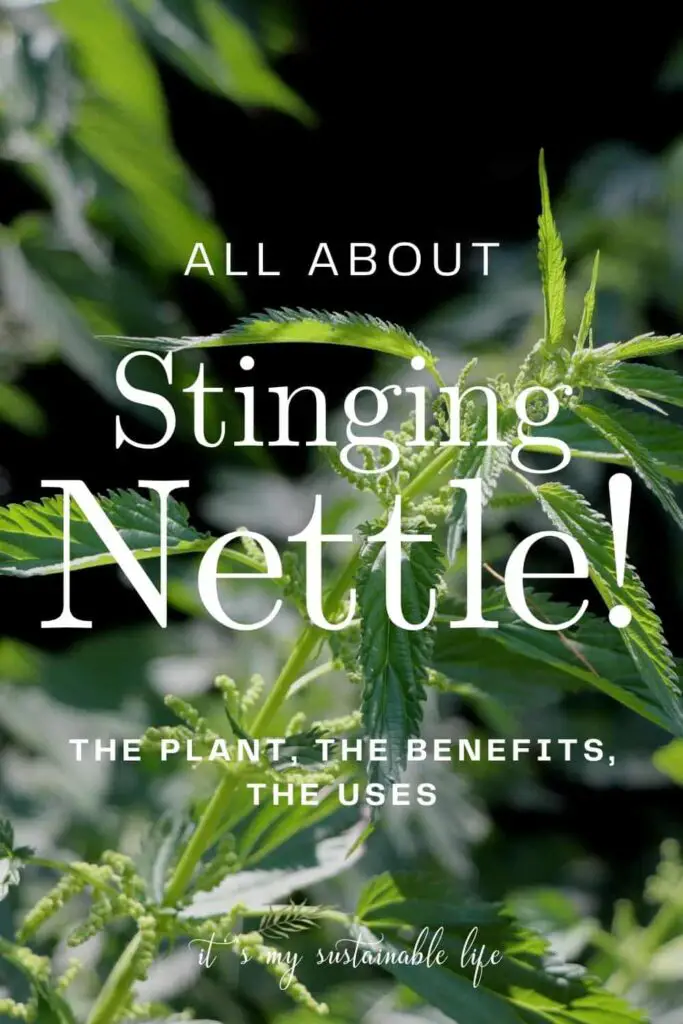
STINGING NETTLES MANY NUTRIENTS
In my humble opinion, stinging nettle may be one of the best superfoods available. A highly nutritive herb full of minerals and vitamins, stinging nettles is one nutritious plant. And now being researched as just that, nutritious.
Some of its many nutrients which stinging nettles offer are …
- MINERALS – Calcium, iron, magnesium, phosphorus, potassium, and sodium
- VITAMINS – Full of Vitamins A, C, K, and several B’s
- AMINO ACIDS – Boasts and contains ALL essential amino acids
- FATS – Linoleic acid, linolenic acid, palmitic acid, stearic acid, and oleic acid
- POLYPHENOLS – Kaempferol, quercetin, caffeic acid, flavonoids
- PIGMENTS – Beta-carotene, lutein, carotenoids
- FIBER – 6 grams found in just 1 cup
- PROTEIN – 2.4 g per cup
In addition, stinging nettle is low in the glycemic index, and many of the listed nutrients act as antioxidants in the body, molecules which help to defend against free-radical cell damage.
STINGING NETTLE HEALTH BENEFITS
Stinging nettle health benefits are many and varied, both nutritionally as well as medicinally. Used throughout millennia as an alternative home remedy for many ailments and issues, it’s one plant we readily harvest and use during the growing season.
Although the science behind the health benefits of stinging nettle is hard to come by, there are a few studies which confirm the folklore beliefs behind this efficacious plant, a few of which are listed below.
STINGING NETTLE HERBAL ACTIONS
Nettle offers a plethora of herbal actions all leading to one thing. Good health.
- DIURETIC
- DETOXIFIER
- ANTI-INFLAMMATORY
- ANTISEPTIC
- ANTIHEMORRHAGIC
- VASODILATOR
- HEMOSTATIC
- CIRCULATORY STIMULANT
- HYPOTENSIVE
- NUTRITIVE
- GALACTAGOGUE
- ASTRINGENT
- ANTI-ALLERGIC
- ANTI-RHEUMATIC
- EXPECTORANT
- ANTI-MICROBIAL
STINGING NETTLE MAY AID
In addition to the herbal actions listed above and their potential health benefits, stinging nettle may offer additional aid in helping diverse issues. A few of which are backed by scientific evidence …
- REDUCE INFLAMMATION – Although inflammation is the body’s natural way to heal, when it becomes chronic it can cause great harm. Stinging nettle offers unique compounds which may help reduce inflammation according to this study
- AIDS IN PAIN REDUCTION – Studies are now indicating that inflammatory issues such as arthritis can be helped with stinging nettle
- ASSIST IN MEN’S HEALTH – BPH, benign prostatic hyperplasia, in men can be helped by stinging nettle. The science community is now showing positive results in helping reduce both prostate size and symptoms in men, especially in helping urinary issues during the early stages
- AID IN LOWERING BLOOD PRESSURE – With as many adults suffering from high blood pressure, putting many at risk for heart disease and strokes, promising studies are now showing this beneficial plant’s ability to help lower the numbers
- AID WITH SEASONAL ALLERGIES – Although it remains inconclusive, giving stinging nettle a try for helping seasonal allergies may be something to consider according to this older study
- DIABETES ASSISTANCE – This case report shows promise in using stinging nettle as an aid in lowering blood sugar levels
STINGING NETTLE CONTRAINDICATIONS
As with all herbs and their preparations, caution should be taken as they can be powerful in themselves. They can, at times, interact with other herbs, supplements, or medications by triggering side effects.
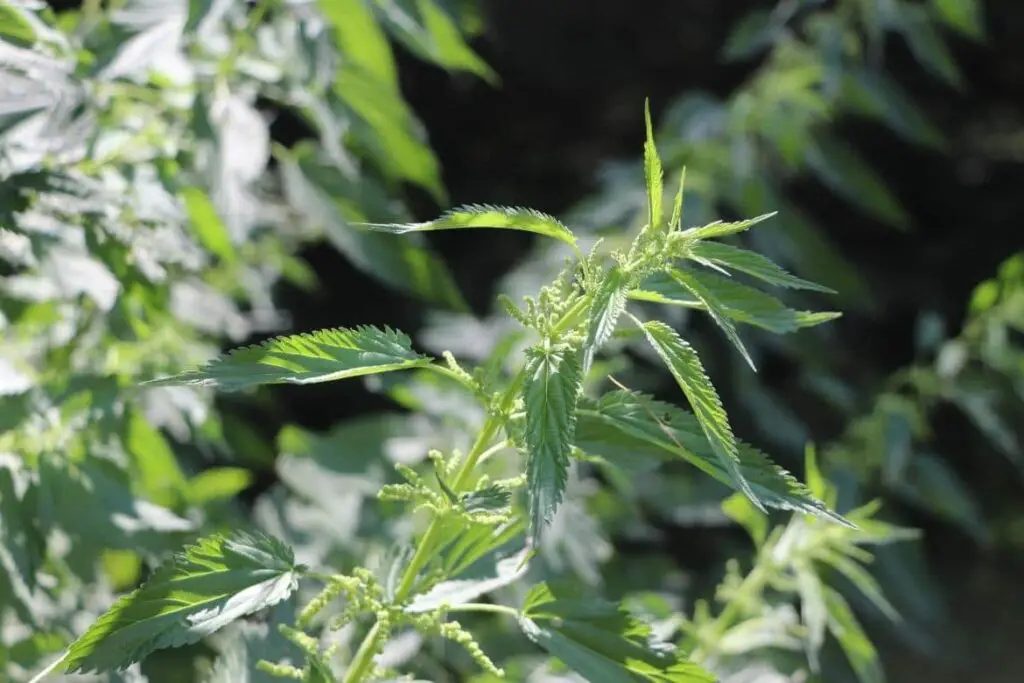
As such, do your due diligence, research and consult with your health care provider before beginning any new herbal regimen.
Stinging nettle is not different from any other herbal approach to wellness. Generally considered safe to use, the occasional issue may arise when taking it, and can include …
- UPSET STOMACH
- HIVES OR RASH
- FLUID RETENTION
- SWEATING
- DIARRHEA
In addition, those considering stinging nettle should be cognizant of the following …
- Pregnant women should be cautious and utilize nettle only under the supervision of your healthcare provider. There is some controversy about its use during pregnancy as many believe it to be a uterine stimulator and can encourage contractions and more.
- Men wanting to use nettle for BPH aid should do so under their health care providers supervision, ruling out any possibilities of prostate cancers.
- Those with diabetes should monitor their blood sugar numbers closely. There is controversy of whether stinging nettle actually may raise blood sugar or lower it.
- As nettle can have a diuretic effect on the body, those with bladder or kidney issues should consult a healthcare provider.
Should you be on any medications consult with your healthcare provider for possible interactions.
STINGING NETTLE USES
Stinging nettle uses are wide and varied. Fortunately, there are choices for how we can utilize them to their fullest potential.
CULINARY
The high mineral, vitamin, and nutrient content of stinging nettle makes it a no-brainer when it comes to adding it to any meal.
The “sting” is removed and no longer a threat once dried or cooked. Obviously, eating raw stinging nettle is not recommended!
Adding nettle, fresh or dried, to soups, pesto, hummus, and just about any savory dish only adds vital and important nutrients.
Consider drying it for use all year long. Powder it and add this superfood to your morning smoothie or encapsulate the powder and take it as a multivitamin.
FIBERS
Mature nettle stems contain strong fibers which have been used & woven into the making of clothing and baskets.
The fiber is harvested from the plant once the stalks have completed its flowering/seed production by rubbing the stalks together, breaking the thin fibers from the stalk.
FIRST AID
Help small wounds including burns, and fight infections by turning dried nettle into a poultice. Alternatively, a simple nettle cream using infused nettle oil can help.
IN THE GARDEN
Our bodies are not the only beneficial recipients of nettle. Our gardens and compost piles can take advantage of this plant’s high vitamin and minerals as well!
I let my nettle grow each year right in my compost pile alongside comfrey until I harvest the nettle root in the fall. Don’t worry about eradicating it by harvesting too much, it’s almost near impossible to do so!
Don’t have a compost pile? Consider making your own homemade plant fertilizer! Simple and quick to make and oh so helpful for your plants’ continued health!
To make your own homemade plant fertilizer …
- 2 C boiling water, add
- ½ C dried nettle leaves
- ½ C dried comfrey leaves
- Cover and allow to cool
- Store in an air-tight container for up to one week in the refrigerator
To use, add ⅓ C homemade fertilizer to 4 cups of water and water your plants. Use this fertilizer no more than once every month.
GENERAL HEALTH
Nettle offers immune support and general overall health. Think of it as a daily multi-vitamin!
Powder it, create capsules, drink it as a tea, or drink an infusion daily for its nutrients.

General women’s health and men’s health will benefit from nettle tea or infusions.
HAIR CARE
Used to strengthen and nourish, the mineral rich nettle vinegar can be diluted with water and used as a hair rinse.
To make your own nettle vinegar simply …
- Place dried vinegar in a jar of choice at least ¼ to ½ full of dried nettle
- Cover the plant material with organic ACV, making sure its covered by at least 2 inches or more
- Cover the jar with parchment paper if using a metal rim or use a non-reactive lid. Label with contents and date
- Place the jar in a dark, cool cupboard for 3 to 6 weeks, giving it a shake every so often
- *You may need to add more ACV as time goes by should the plant material swell
- Strain and store in a clean jar and use
Nettle vinegar may also be used in cooking; dressings, marinades, soups. It can also be diluted with water and used as a facial toner as well as the hair rinse.
Stored appropriately, it should last at least one year.
HAY FEVER
The naturally occurring histamine in stinging nettle may aid those dealing with hay fever allergies. Good news for those who deal with seasonal allergies!
Utilizing a simple tincture made from the fresh leaves of the stinging nettle plant can help reduce overall allergy symptoms.
You may want to consider making your own “allergy relief” tincture by placing the following in a pint jar …
- 2 C fresh nettle leaves, chopped wearing protective gloves and long sleeves
- ⅛ C bee pollen (local within 5 miles of your location is best)
- 1.5 C (or slightly more) 100 proof vodka
- Cap, label, store in a dark, cool spot for a minimum of 6 weeks or up to 6 months. Strain the liquid from the plant material into a dark amber colored glass bottle, label, and store.
I highly recommend beginning this regimen at least 2 to 3 months PRIOR to allergy season for the greatest benefit. Adults can take ½ to 1 tsp up to 3x per day.
Alternatively, you could powder the ingredients and create your own allergy relief capsules.
INFLAMMATORY ISSUES
When suffering from inflammatory issues such as arthritis and joint pain, consider stinging nettle.
Infuse dried nettle into a carrier oil of your choice (I prefer an organic EVOO) and massage into affected areas for joint and pain relief.
Alternatively, you can make a salve or balm for relief using the infused nettle oil. Directions for making your own can be found here. Simply sub the ingredients listed and use only the nettle infused oil and beeswax at a 7:1 ratio.
SEASONAL VIRUS AID
When the seasonal virus season is upon us, drinking nettle tea or an infusion of nettle is beneficial. Complete instructions on creating herbal infusions can be found here.
Why? For its many nutrients, vitamins, and minerals! Stinging nettle tea & infusions are nourishing, offer aid in supporting the immune system, and comes to the rescue of lung related issues related to seasonal viruses.
Stinging nettle may be the most efficacious, beneficial, and useful plants we have available! “Love bites” notwithstanding, the nettle plant is one I hope you will take advantage of.
Has this overview of the stinging nettle {the plant, the benefits, and the uses} inspired you to utilize nettles?
Love, Light, & Laughter ~

Enjoy this article? Please consider sharing it on your favorite social media channel! Want more? Subscribe below for the occasional update with all the “happenings on the hill”!
SHOP THIS POST
HAVE YOU SEEN THE LATEST?
- How To Sanitize Seed Trays
- How Often To Water Tomato Plants
- Winter Sowing In Milk Jugs
- How To Appliqué
- What Food Group Are Eggs In

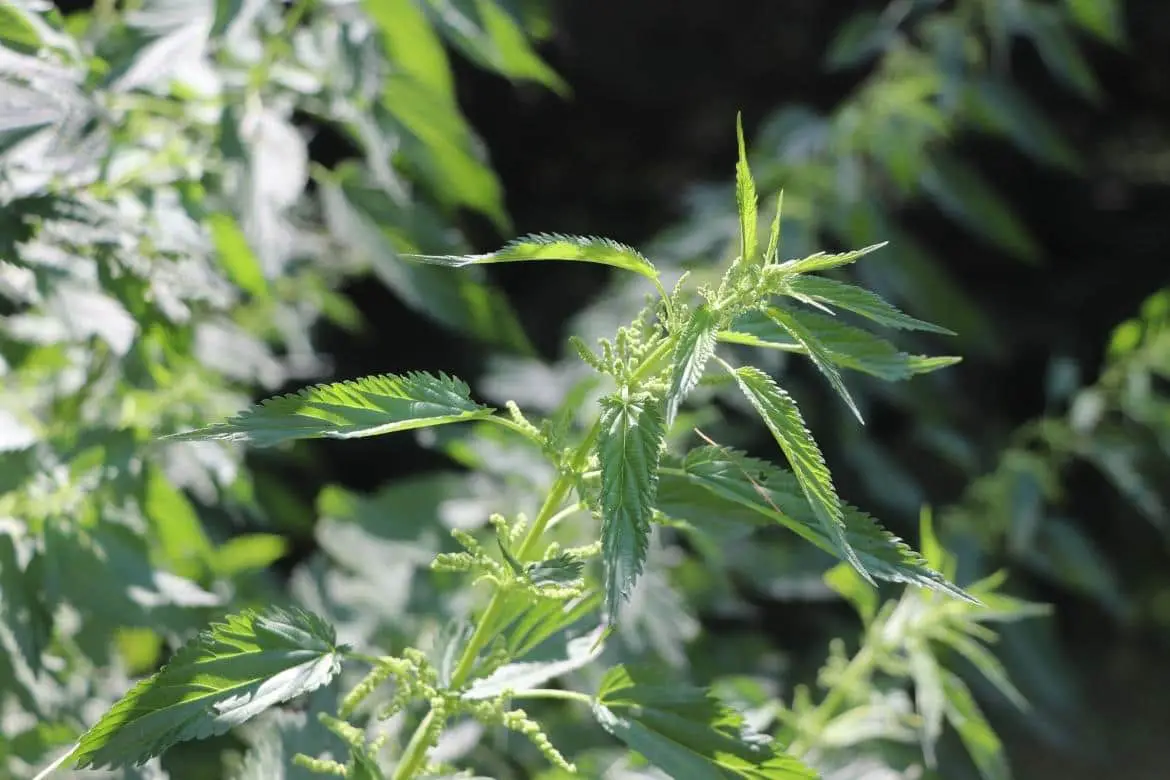

15 comments
I try and avoid stinging nettles at all costs, but it’s nice to know there are some benefits that may outweigh the bad! Sim x hopping over from #DareToShareLinky
We’re featuring you this Wednesday on the Homestead Blog Hop! Thank you so much for always sharing such great content. It’s always so practical and useful. I love to see what you bring each week.
Love all of the benefits and uses of the stinging nettle. Thanks for sharing.
This is such interesting information! I am in awe of this natural wonder! I am enjoying learning about the plants growing in my field and yard!
I love stinging nettle! It’s my go to hot herbal tea when I feel a cold coming on. So many other uses too.
I had no idea that there were benefits to stinging nettle! I’m not sure if I’m brave enough to process the plant for them though…
This is so interesting! I’d never heard of stinging nettle before, or any nettle for that matter. The benefits reminded me of what I learned this summer about the Navajo uses of plants for hair care.
It DOES help to know that there are positive uses!
I love stinging nettle! It’s one of my go to herbs. It’s so versatile. And if I feel a cold coming on, nettle tea seems to stop it or helps me get over it quickly.
I’ll be honest, I’ve never heard of stinging nettle, or any nettle, for that matter. The fact that you can use it on your hair reminded me of my trip to Navajo Nation where they explained some plants they use for hair care. So interesting!
I had no idea stinging nettle has so many health benefits. I think I may try it for the inflammation I have in my hands.
So cool, I would never have thought to pick that! I definitely need to make the recipe to help with hay fever!
I use nettle leaf tea for inflammation! But I’ve never grown it before. Sounds like it’s stinging properties are pretty strong! Thanks for the tips!
I always like to think the benefits outweigh the negative, but I am not so sure I would want to harvest this plant 🙂 I would like to avoid the stinging nettle!
Thanks for so much info about stinging nettle. I am not familiar with it so really appreciate this post.